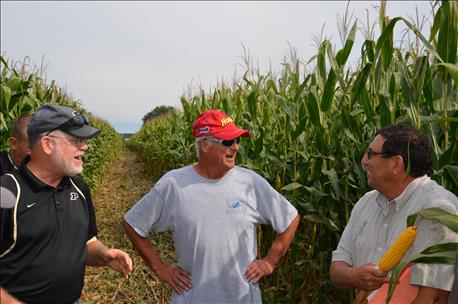
Bob Nielsen has served as Purdue University Extension’s corn specialist for more than 30 years. Whether you agree with everything he has said over those three-plus decades or not, you know his name, and you know he is dedicated to helping farmers grow corn. There is no debate about that fact.
Nielsen hails from Nebraska, a big corn growing state. He studied plant genetics and agronomy before graduating and earning advanced degrees.
Here are five reasons why Indiana is better off because Bob Nielsen is here.
1. He pioneered research showing that uneven planting stands and emergence hurts yields

SOLID RESEARCHERS: Bob Nielsen, left, and Jim Camberato, far right, now do some of their best work on farms. Here they were discussing results of a nitrogen trial Ken Simpson, center, Morristown.
Finger pick up planters had been around for many years before Nielsen arrived- just about long enough for many of them to wear enough so that they didn’t perform like they did when they were new. It was Nielsen who opened people’s eyes about the need to perform planter maintenance and repair so that these planters once again could deliver picket-fence stands, like they were designed to do.
2. Shake it up, Bob!
Whether he knew it or not, Bob Nielsen started a craze when he began showing visitors to the Purdue University Diagnostic Clinic field day how to determine if pollination was complete or not. He popularized the simple ‘shake test.’
While the concept was simple- pulling back shucks, shaking the ear and see if silks fell off or stayed attached, it was something many farmers hadn’t seen done before. By the way, if the silks fall off, the kernels are pollinated. If they stay on, those potential kernels aren’t pollinated yet.
3. Why should Hoosier farmers have to rely on nitrogen rates from Iowa?
Why indeed! For many years agronomists and even writers like me sent you to the Iowa State University Web site to check on recommended nitrogen rates. Iowa State had developed a nitrogen rate calculator. You put in various factors about your field, and it spit out recommendations. It was powered by test data from numerous trials. The problem was there wasn’t solid information from Indiana.
“Jim Camberato and I set out to get that data for Indiana farmers about a decade ago,” Nielsen explains. “it just didn’t exist- at least not for all areas of the state. Most of the data we had was form nay years earlier.”
When you want a recommendation for corn in Indiana now, Nielsen can provide data backed by multiple years of research here in the state. And he can show you that there is a difference in how much you should apply, based on where you live. If you live in west-central Indiana you can apply less. If you live in east-central Indiana you need to apply substantially more. It’s not guesswork- it’s backed by data.
4. GPS and auto-steer works, and it opens up whole new possibilities!
Once Nielsen and Camberato determined that GPS was accurate enough for helping plant plots and combine those same plots, they saw a huge opportunity to get more valid research. They could now work with farmers on their own farms and do field-size research. And it wouldn’t take the farmer tons of extra time to do the trials. The ability to plant by GPS and control various variables from the cab, such as to change nitrogen rate, made their trials possible. The pair now works with dozens of farmers statewide. And they’re always looking for more!
5. Trust me- those yield monitors must be calibrated!
Credit Nielsen with being one of the voices out there insisting that to be helpful, yield monitors need to be calibrated. I believed him, but I trusted his wisdom even more after I saw how calibration errors could interfere with results in a trial of my own a couple years ago. If you want good stands, you need to take the time to calibrate. It’s just another concept the Nebraskan-turned Hoosier had brought to Indiana!
About the Author(s)
You May Also Like




